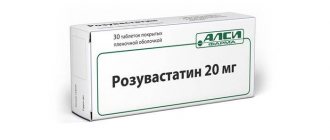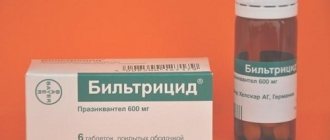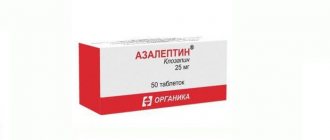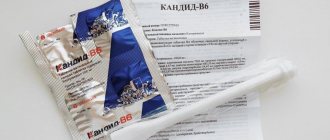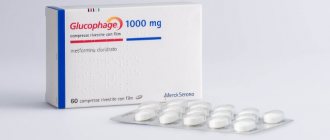Sumatriptan tablets ppo 50 mg No. 2
special instructions
Sumatriptan should only be used in patients with an established diagnosis of migraine.
The use of sumatriptan is not indicated for hemiplegic, basilar and ophthalmoplegic migraine. Do not exceed recommended doses of sumatriptan.
As with other medications used to treat acute migraine attacks, other potentially serious neurological pathologies should be excluded before treating a headache attack in patients who have not previously been diagnosed with migraine or in patients with atypical migraine. It should be noted that patients with migraine have an increased risk of developing certain cerebrovascular events (eg, stroke or transient ischemic attack (TIA)).
After taking Sumatrintan, transient symptoms such as pain and tightness in the chest may occur. Symptoms can be intense and extend to the neck area. If there is reason to believe that these symptoms are a manifestation of coronary heart disease (CHD), further use of sumatriptan should be discontinued and appropriate diagnostic testing should be performed.
Patients with risk factors for developing coronary heart disease, incl. heavy smokers or patients using nicotine replacement therapy should not be prescribed sumatriptan without prior examination of the cardiovascular system. Particular attention should be paid to postmenopausal women and men over 40 years of age who have these risk factors. However, testing does not always detect heart disease, and in very rare cases, serious cardiac complications have occurred in patients without underlying cardiovascular disease.
Sumatriptan should be used with caution in patients with controlled mild hypertension, as a transient increase in blood pressure and peripheral vascular resistance was observed in a small number of patients.
There are rare reports from post-marketing surveillance of the development of serotonin syndrome (including mental status disorders, autonomic lability and neuromuscular disorders) as a result of concomitant use of selective serotonin reuptake inhibitors (SSRIs) and sumatriptan. The development of serotonin syndrome has also been reported during concomitant use of sumatriptan with triptans and selective norepinephrine reuptake inhibitors (SNRIs).
If concomitant use of SSRIs and/or SNRIs is clinically warranted in a patient, the patient's condition should be carefully monitored.
Sumatriptan should be used with caution in patients in whom the absorption, metabolism, or excretion of sumatriptan may be significantly altered, such as patients with hepatic impairment or impaired renal function. In patients with liver failure, the initial dose should be 50 mg.
Sumatriptan should be used with caution in patients with a history of seizures or other risk factors for lowering the seizure threshold, as cases of seizures have been reported while taking sumatriptan.
In patients with established hypersensitivity to sulfonamides, taking Sumatriptan may cause allergic reactions that range from cutaneous hypersensitivity reactions to anaphylaxis. Cross-sensitivity data are limited and caution should be exercised before administering sumatriptan to these patients.
Adverse reactions may occur more frequently with the simultaneous use of triptans and medications containing St. John's wort.
Long-term use of any type of painkiller for headaches can make them worse. If this situation occurs or is suspected, it is necessary to stop therapy and conduct additional examination. Drug overuse headache may be suspected in patients who experience recurrent or daily headaches despite regular use of headache medications.
Patients with rare hereditary lactose intolerance, lactase deficiency and glucose-galactose malabsorption should not take Sumatrintan, as it contains lactose.
Pharmacological properties of the drug Sumatriptan
Sumatriptan is a specific selective agonist of 5HT1 receptors (5-hydroxytryptamine-1-like) and does not act on receptors of other subtypes. 5HT1 serotonin receptors are located predominantly in the craniocerebral vessels. In animals, sumatriptan selectively narrows the lumen of blood vessels in the carotid artery system, but does not affect cerebral blood flow. The carotid artery system supplies blood to extracranial and intracranial tissues, such as the meninges; It is believed that the dilation of these vessels is the main pathogenetic factor in the development of a migraine attack in humans. It has also been experimentally established that sumatriptan affects the endings of the trigeminal nerves. Both effects may contribute to the antimigraine activity of sumatriptan in humans. After oral administration, sumatriptan is quickly absorbed from the digestive tract; after 45 minutes its concentration in the blood serum reaches 70% of the maximum. Bioavailability after oral administration is about 14% (due to first-pass metabolism and incomplete absorption in the intestine). Plasma protein binding is low - 14–21%.
Drug interactions Sumatriptan
There are no indications of interaction with propranolol, flunarizine, pizotifen or alcohol. With the simultaneous administration of sumatriptan and ergot alkaloids, severe vasospasm may develop, and therefore it is necessary to observe a 24-hour interval between taking ergotamine-containing drugs and sumatriptan. On the other hand, ergotamine-containing drugs should not be used earlier than 6 hours after taking sumatriptan. Interactions may occur between sumatriptan and MAO inhibitors, so their combined use is contraindicated. Rarely, interactions may occur between sumatriptan and selective serotonin reuptake inhibitors.
Sumatriptan drug overdose, symptoms and treatment
With a single subcutaneous administration at a dose of 12 mg, sumatriptan did not cause overdose symptoms; in doses exceeding 16 mg for subcutaneous administration and 400 mg for oral administration, sumatriptan did not cause the development of reactions other than those mentioned in the SIDE EFFECTS section. It is recommended to provide medical supervision for 10 hours, and if necessary, provide maintenance therapy. The effectiveness of hemodialysis and peritoneal dialysis has not been established.
List of pharmacies where you can buy Sumatriptan:
- Moscow
- Saint Petersburg
Side effects
As a result of clinical studies, several side effects that occur after taking the medicine have been identified. The main negative reactions are reflected in the following list:
- decreased blood pressure;
- bradycardia, tachycardia and other heart rhythm disturbances;
- burning or irritation in the nasal cavity;
- dyspnea;
- decreased visual acuity;
- diplopia;
- dizziness;
- blood from the nose;
- vomit;
- feeling hot or cold;
- weakness;
- epileptic seizures;
- dysgraphia and ischemic colitis;
- fast fatiguability;
- skin rashes with itching and anaphylactic reactions;
- tides;
- a feeling of squeezing, tightening and heaviness in different parts of the body4
- sometimes Raynaud's syndrome and myalgia.
Use of the drug Sumatriptan
Not used to prevent attacks. Sumatriptan should be taken as soon as possible after the onset of a migraine attack, but it is equally effective at any stage of the attack. The recommended dose for adults is 50 mg; some patients may require a dose of 100 mg. If the first dose is insufficiently effective, it should not be taken again during the same attack. If the attack recurs, you can take sumatriptan again; the daily dose should not exceed 300 mg. The effectiveness and safety of sumatriptan in children has not been established.
Analogs
Migraine tablets Sumatriptan have several analogues. They are divided into 2 categories. The first is similar to this medicine in composition, and the second is similar in principle of action. Among the popular analogues are:
- Sumatriptan-Teva. Available only in a dosage of 50 mg. Otherwise, the drug has virtually no differences.
- Rapidmed. Based on the same substance. The difference between this medicine is that the peak concentration of the medicine occurs 2-2.5 hours after administration. The medicine is eliminated from the body longer – in 2.5 hours.
- Amigrenin. Used for migraines with or without aura. Instructions for use are similar. This remedy is used with caution for arterial hypertension and epilepsy.
- Sumamigrain. It is based on the same active component, exhibits a similar principle of action, therefore it is a complete analogue of this medicine.
Contraindications
If you are allergic to the composition of the medicine, taking it is contraindicated. The same applies to individual hypersensitivity of the components of Sumatriptan. Other contraindications include:
- severe cerebrovascular accident and stroke in the patient's history;
- age under 18 and after 65 years;
- previous myocardial infarction;
- cardiac ischemia;
- Prinzmetal's angina;
- vascular diseases on the periphery that are occlusive in nature;
- severe liver dysfunction;
- therapy with MAO inhibitors, 5-HT1 receptor agonists, ergotamine and its derivatives.
Side effects of the drug Sumatriptan
General: pain, sensations of tingling, warmth, heaviness, pressure or tension (these symptoms are usually transient, can be quite intense and occur anywhere in the body, including the chest and larynx), flushing, dizziness, general weakness, fatigue, drowsiness (usually moderate and disappear quickly). From the cardiovascular system: arterial hypotension, bradycardia, tachycardia, transient increase in blood pressure that occurs soon after completion of treatment; rarely - heart rhythm disturbances, transient ischemic changes on the ECG, myocardial infarction. From the digestive system: nausea and vomiting (a clear cause-and-effect relationship with the use of sumatriptan has not been established). From the nervous system and sensory organs: rarely - convulsive seizures (most of these patients had a history of indications of epilepsy or organic brain damage); blurred visual perception, diplopia, nystagmus, scotoma, decreased visual acuity, very rarely, transient blindness (sometimes visual impairment can be a consequence of a migraine attack). Hypersensitivity reactions (from allergic skin reactions to anaphylaxis) may occur, as well as minor changes in liver function tests.
Sumatriptan price
The cost of the drug depends on the concentration of the active component and the markup of a particular pharmacy. The average price for 2 tablets does not exceed 150-200 rubles. Examples of costs in different pharmacies are presented in the table:
| Place of purchase | Release form | Quantity, volume | Price, rubles |
| WER.ru | Tablets 100 mg | 2 pcs. | 145 |
| Tablets 50 mg | 2 pcs. | 81 | |
| Zdrav Zone | Tablets 100 mg | 2 pcs. | 162 |
| Tablets 50 mg | 2 pcs. | 72 | |
| Tablets 100 mg | 10 pieces. | 629 | |
| Pharmacy IFC | Tablets 100 mg | 2 pcs. | 201 |
| Tablets 100 mg | 6 pcs. | 900 |
